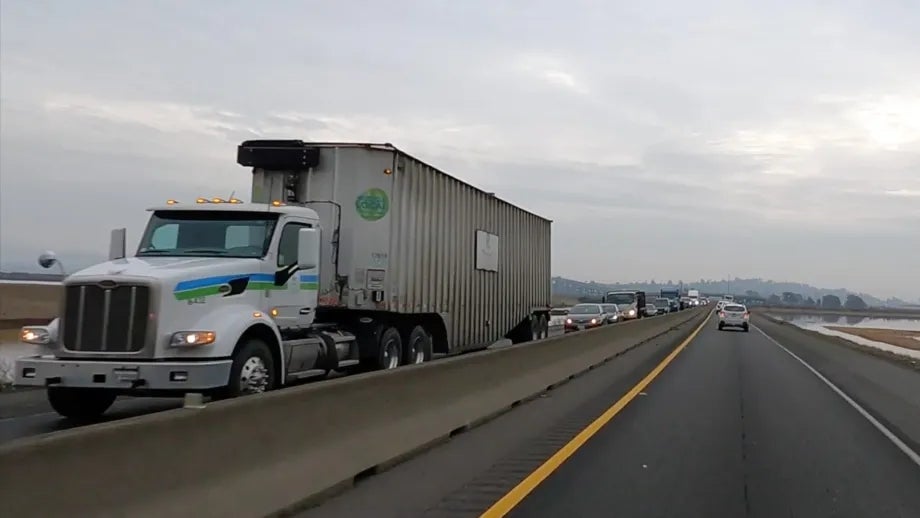State, Local Agencies Announce Commitments to Create a Climate-Resilient Highway 37
State and local agencies today announced a partnership agreement and a suite of commitments to implement near-term improvements to the San Francisco Bay Area’s Highway 37 while pursuing long-term projects to create a more climate-resilient corridor. The 21-mile-long roadway from U.S. 101 to I-80 connects job markets and housing within Marin, Sonoma, Napa and Solano counties.
The partnership agreement among MTC, the San Francisco Bay Conservation and Development Commission (BCDC), the California Natural Resources Agency, the California State Transportation Agency (CalSTA), Caltrans District 4 and the California Department of Fish and Wildlife commits the agencies to develop and implement both near- and long-term projects to improve a critical regional transportation corridor. This agreement is the first step toward a re-envisioned Highway 37 that is resilient to sea-level rise, protects critical marsh and tidal habitats, reduces transportation inequities, and incorporates bicycle, pedestrian, transit and carpool options for travelers.
Used by more than 40,000 vehicles a day, Highway 37 is prone to traffic congestion and periodic flooding. Rising sea levels are expected to cause greater and more frequent inundation. Nearly the entire length between Novato and Vallejo is predicted to become permanently submerged as sea levels rise if modifications are not made. The result would be additional traffic congestion on distant roadways, economic loss and reduced opportunity for commuters from disadvantaged communities.
The corridor cuts through a mosaic of tidal and seasonal wetlands – some of the last, best natural habitat for plants and animals in the entire region. The wetlands themselves serve as nature-based climate buffers to sea level rise and extreme weather events while existing within a landscape of urban areas, agricultural land, and other infrastructure.
“This important partnership fulfills the urgent need to fortify Highway 37 to meet the demands of today while preparing for the long-term challenges of tomorrow with a focus on safety, equity, climate action and economic prosperity,” said California Transportation Secretary Toks Omishakin. “I thank all our partners for coming together on solutions that will help this vital corridor, the communities it connects and its surrounding ecosystems thrive for generations to come.”
“This agreement puts us on a clear pathway to improve Highway 37 so it works better for all who use it and ensures it can withstand climate change impacts in coming decades,” said California Natural Resources Secretary Wade Crowfoot. “This agreement will also help protect and restore the unique habitats of the North Bay. Now we need to follow through and implement this agreement to realize these improvements as quickly as possible.”
“By uniting MTC, Caltrans, and CalSTA with BCDC, the state Department of Fish & Wildlife, and the Natural Resources Agency, the partnership agreement really highlights how important it is to make both near-term and long-term improvements to the Highway 37 corridor; not just for drivers but also for the baylands and the plants and animals who live there,” said MTC Chair and Napa County Supervisor Alfredo Pedroza. “This is a team effort and the time to get to work is now.”
Near-term projects, including the Sears Point to Mare Island Improvement Project, focus on improving quality of life for lower income workers, including teachers, caregivers and service providers who rely on Highway 37 to access jobs in Sonoma, Napa and Marin Counties where affordable housing is in short supply. It is aimed at reducing peak travel times, where delays approach 2 hours per day, providing a high-occupancy vehicle (HOV) lane to make transit service and carpooling a more viable and attractive option, while also addressing near-term flooding risk on the portion of Highway 37 from Mare Island in Vallejo to Highway 121 in Sonoma County.
The project proposes adding a lane in each direction and converting the existing lane in each direction into an HOV lane. The new lane is proposed to be tolled to encourage HOVs – including transit users and rideshare – to avoid inducing vehicle miles traveled and to raise funds needed for direct contribution and as match for federal and state funds. The option to toll will be pursued through an application to the California Transportation Commission under their existing tolling authority. The parties will work together through final design and implementation of this project to minimize impacts to existing natural resources and preserve the potential for future conservation and ecological restoration. Additionally, as part of the near-term project implementation, the agreement includes early implementation of key elements of the Sonoma Creek Baylands strategy including wetlands restoration and the replacement of Tolay Creek, which will increase tidal connectivity with habitats north of Highway 37.
A suite of long-term resiliency projects will make the entirety of Highway 37 from the intersection with U.S. 101 in Marin County to the intersection with Interstate 80 in Solano County resilient to sea-level rise over the long term. Caltrans completed the Planning & Environmental Linkages (PEL) Study in December that envisions not just two lanes in each direction, but also a fully protected bicycle and pedestrian path and rail connectivity. The preferred alternative identified in the PEL study is a fully elevated causeway that will enable habitat restoration by restoring hydrological connection between San Francisco Bay and the Baylands.
This alternative will enable landscape-scale restoration of the historical North Bay Baylands, facilitating natural flood protection. Additionally, these restored wetlands will provide habitat for a number of endangered species, including the salt marsh harvest mouse, Ridgway’s rail, Black rail, and California red-legged frog.
Future steps include active collaboration among the signatories to expedite completion of the design, permitting and implementation of both the near- and long-term projects to ensure an equitable, resilient and ecologically beneficial corridor.


Submit your comment
In order to receive a reply to your comment, please provide an email address.